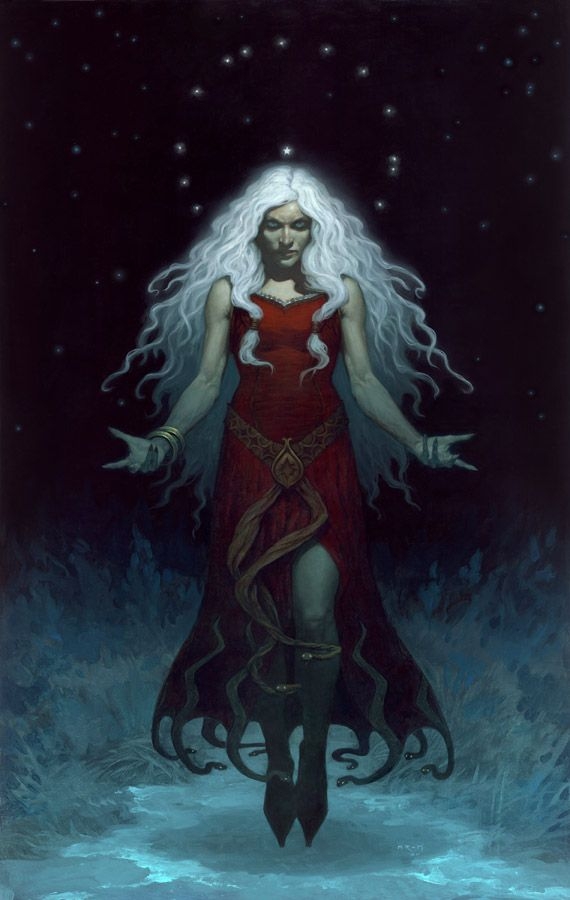The Winter Witch
Pastor’s Epistle—December 2020
Christmas is a season of light amongst the darkness, warmth amidst the snows. But with all our modern conveniences, central heating and electric lights, we can tend to ignore the darkness completely. Such was never really the case in Germany.
Germany has always retained the darker side of Christmas, as typified by Krampus, the Christmas Devil, who accompanies St Nicholas on his rounds, punishing naughty children as St Nick rewards the good. The Christmas Devil comes in many guises and iterations; the one I grew up with was der Belsnickel, begrimed and clad in furs, who brought not coal but birch switches to the houses of deserving little tykes.
When first we moved to New York Mills, some 13 winters back, few appeared to be aware of Krampus in any of his forms. Most looked at me, when I spoke of such things, as though I’d grown a third eye. These days, however, Krampus with his kith and kin seem to be cropping up darn near everywhere. There are books, dolls, greeting cards, major motion pictures, even a Minnesota Krampus Society roaming about the state.
And so perhaps the time is ripe to introduce you to another Germanic Christmas monster, one still a bit more obscure, yet no less beloved: a woman this time, alternately known as a witch, a goddess, a monster, and a holiday. She goes by many names, but is most commonly called Frau Holle in the north and Perchta in the south. And she can at times make Krampus seem positively tame by comparison.
The Brothers Grimm tell the tale of a young woman who falls down a well, only to find herself in a lush and beautiful land underground. Here she finds work with Frau Holle, a matronly figure whose actions below influence the world above. When Frau Holle shakes out her feather bed, it snows in our world. When her pots steam and boil on the stove, mists rise up from the swamps. She is kindly to the diligent, gentle, and hard-working, but mercilessly punishes the lazy and the crass.
Frau Holle, or Perchta, can appear as a beautiful young woman, a Lady of the Snows; or as the grandmotherly crone from the Grimms’ tales. But her third and most terrifying form is that of a monstrous hag, stooped and deadly, long of tooth and claw, carrying a cleaver or a sickle with which to do her dirty work. Like Baba Yaga for the Russians, Perchta might help you, or she might eat you. You never really know, and it’s all the same to her.
Most people hear of Frau Holle and assume that she’s a goddess, a Germanic or perhaps even Celtic holdover from a pre-Christian time. But we haven’t any proof of this, and indeed it looks as though her name, Perchta, derives from the feast of Epiphany on 6 January. In other words, there’s a good chance that she started out as the personification of a Christian holiday. Her twin aspects—kind and cruel, matron and monster—derive from the fact that she brings with her both Christmas and winter.
This explains why her Italian counterpart, La Befana, is forever following after the Wise Men in search of the Christchild. The hair-raising stories of Perchta’s punishments meted out upon the wicked (I’ll spare you the gory details, but she isn’t called the Christmas Belly-Slitter for nothing) tend to fall upon those who fail to keep a fast before the Epiphany feast. She proves herself a scrupulously religious ogress.
Even in the Brothers Grimm, one cannot shake the impression that this enigmatic woman somehow mysteriously works for God. Or maybe that’s just me.
Pagan or Christian, healer or horror, Frau Holle has come to embody winter itself, and the dual aspects of our holiday season: darkness and light, cold and warmth, death outside and life within, the joys and generosity of Christmas along with all the anxieties and fears that the Yuletide often brings. It’s a package deal, to be honest.
We can be excited about Christmas and dread it at the same time. It’s okay to not be okay at the holidays, especially given the year we’ve all just been through.
So go ahead and embrace the ambiguity. Our forebears certainly did. The Victorians loved to tell ghost stories over the Twelve Days of Christmas, a tradition exemplified by Charles Dickens’ A Christmas Carol. Or try out the Nordic notion of the Year Walk, a silent, spooky midnight trek to a graveyard on New Year’s Eve. Or just stay at home with carols, cocoa, and candy canes, whatever floats your boat.
My point is that Christ is with us us wherever we find ourselves: happy, sad, frightened, tired, excited, serene, relieved, or depressed. Jesus Christ is born for you. God has descended from heaven for you. And whether you’re a shepherd or an angel, a magi or a monster, salvation will find you where you are, and will never leave you the same.
Merry Christmas.
In Jesus. Amen.

Comments
Post a Comment